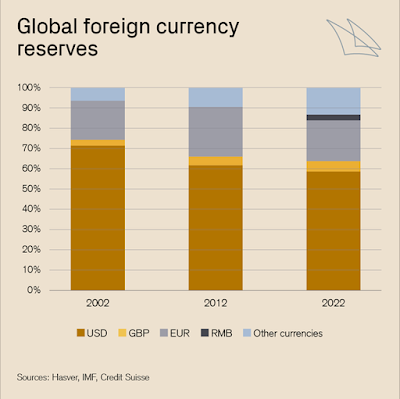Monetary largesse and ballooning public debt have been fueling the growth of the money supply. As a result, the fiat based monetary system has been experiencing its first inflationary surge in the 21st century. What does the future hold for the monetary system? Macroeconomic imbalances and geopolitics may accelerate change in the current largely USD-based monetary system into a more multipolar one.
Since its
launch in 1944, the USD-centric monetary system has undergone radical change,
typically in response to "systemic" crises such as major shifts in US
monetary policy that generated stresses outside the United States.
In recent
years, the changes in the global economy, economic policy responses, and the
geopolitical situation have triggered hefty reactions in financial markets,
including money, bond, and foreign exchange markets. They have also raised the
question as to whether the international monetary system may be subject to more
long-term and fundamental changes.
In which
direction is the monetary system heading?
It seems as if a gradual evolution to a more multipolar monetary system is the most probable outcome, with a more extreme turn away from the USD-centric system being much less likely.
Two unlikely scenarios: A common global currency or a different currency hegemon
1. Creation
of a common global currency remains illusory
Proposals
for a world currency have not materialized and, in the current geopolitical
setting, are now even less likely. Put simply, handing over the power to print
money from your own central bank to a supranational authority requires enormous
mutual trust among countries and an intensely cooperative geopolitical
environment.
2. Lack of
an alternative currency hegemon
How about a
currency other than the US dollar to take on a similarly dominant role in the
global monetary system?
There are
two regions that are similar in economic size to the United States, and which
by their scale might in principle qualify: the euro zone and China.
Euro zone
The euro
now accounts for around 20% of global FX reserves – the second largest share
behind the US dollar – and is also freely tradable across borders. And yet,
euro zone policy makers are clearly not striving for their currency to take on
such a role; indeed the focus of the European Central Bank (ECB) remains very
much on the domestic economy.
Alternatives
The
creation of a truly new global currency, or the rise of an alternative
"hegemonic" currency is, in our view, very unlikely in the
foreseeable future.
So, what
might a future monetary system look like in the absence of either a new world
currency or a full replacement of the US dollar as the lead currency?
Gradual
evolution of a more multipolar system
Essentially
we see a new, more multipolar system evolving as a result of four drivers:
1. the
trend increase in bilateral trade among many countries, allowing for returns to
scale in the use of their respective currencies rather than the US dollar;
2.
deepening of local capital markets in emerging markets;
 |
Transactions
in emerging market currencies are on the increase; Source:
BIS, Credit Suisse |
Since the
financial crisis of 2008 we have seen efforts to increase the robustness of the
monetary system and better protect emerging markets from the stresses that
arise from the US dollar-centric system.
This means
the world has gradually been moving toward a more multipolar currency system.
The question is whether this process will continue in a fairly smooth manner,
or whether we might see abrupt moves in one or the other direction.
This blog article is anchored on what is available in the press release of the extended report with the same title. You can read the press release and download the report on this Credit Suisse Research page.

No comments:
Post a Comment